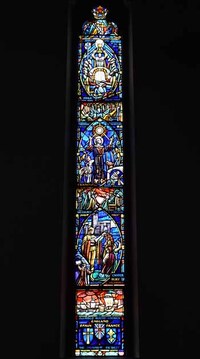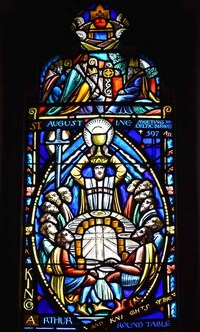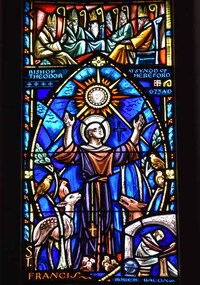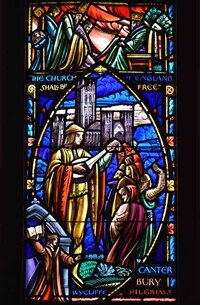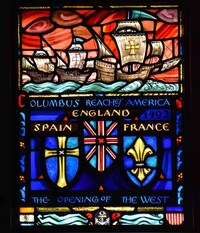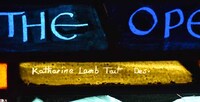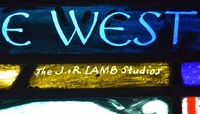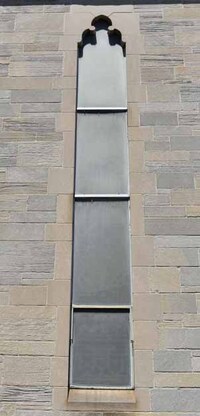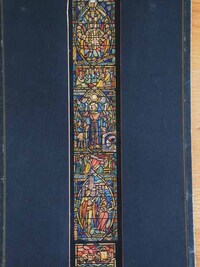Window
Building Name: All Saints Episcopal ChurchStudio Name: Lamb (J. and R.) Co.
City: Detroit
Window Shape: 3 (arched)
Subject/Title of Window: History of the Church Part 3 St. Augustine of Canterbury to Colonization of America
Brief Description of Subject: Information from Charles J. Connick Associates worksheet 3401. Planning for four windows in the south nave began in 1952. The subject was to be the history of the Church from the Old Testament to the Michigan Diocese. In 1955 the Church was still trying to figure out what they wanted included on those windows.
Sometime after this, the Church switched to the J.&R. Lamb Studios to design and make those windows. Each of the four windows contain eight scenes.
In the small roundel above Scene 1 is the "Throne of Heaven" --- Orbus Cruciger sitting on the throne surrounded by angels. This is mentioned in Revelation 7:11, " All the angels were standing around the throne ... and worshipping God."
Scene 1: St. Augustine of Canterbury is known as the founder of the English Church. A Benedictine monk who was sent to convert the Anglo Saxons to Christianity. He landed in Kent in 597 and converted the King and established a Church in Canterbury. The King brokered a meeting with bishops of the Celtic Church to unite them with the Church in Rome. Their first meeting was encouraging but a subsequent one ended in discord.
Scene 2: King Arthur and the Knights of the Round Table. A legendary King, who with the Knights of the Round Table, defended Britain against 6th Century Saxon invaders. The Knights would go on to search Europe for the Holy Grail --- the cup used at the Last Supper and collected Christ's blood at the Crucifixion. It is seen here being raised by King Arthur. Also seen is Excalibur, King Arthur's sword.
Scene 3: Bishop Theodor at the Synod of Hereford 673. The synod was assembled by Bishop Theodor, the Archbishop of Canterbury, to unite the Anglo Saxon Bishops with the Church in Rome. Where Augustine had failed, Bishop Theodor succeeded in unifying the English Church.
Scene 4: St. Francis of Assisi (c. 1181 -1226) is pictured in the habit of the Franciscan Order that he had founded. Above him, the sun references his composition of the "Canticle of Brother Sun and Sister Moon." The wolf comes from the legend that while at Gubbio a wolf that was terrorizing the livestock, approached him with an open mouth. When Francis made the sign of the cross the wolf became tamed.The birds come from his sermon to them and recorded by monks that begins "My sweet little sisters, birds of the sky, you are bound to heaven, to God, your Creator."
Roger Bacon (1220 - 1292) seen here at a writing table and books and a globe on the floor. He became a Franciscan friar and is known for what is now called "empiricism." He wrote extensively on the natural sciences and stressed the Bible in Theology.
Scene 5: Pictured is King John of England signing the Magna Carta in 1215. The Magna Carta is a forerunner of our Bill of Rights. Article 1 of the Magna Carta reads: "First, that we have granted to God, and by the present charter have confirmed for us our heirs in perpetuity, that the English Church shall be free and to have all its rights fully and its liberty entirely."
Scene 6: Canterbury Pilgrims: Thomas Becket was the Archbishop of Canterbury when he was assassinated by knights sent by Henry II in 1170. He was buried at the Cathedral and his tomb became, and still is, a major pilgrimage site. Most of what is known of the early pilgrimages comes from Geffery Chaucher's book "Canterbury Tales."
John Wycliffe (1328 - 1384) was a Catholic priest who questioned many beliefs and practices of the Church. He is considered a predecessor of Protestantism. He and his followers are credited with being the first to translate the Bible into English.
Scene 7: Columbus reaches America in 1492. Pictured are his three ships for that historic journey. The smaller ones are the Nina and the Pinta, while the largest one, the Santa Maria, was Columbus's flagship.
Scene 8: Spain. England and France, shown here with their shields, are the countries that colonized America. This opening of the west (the New World) brought Christianity with it. Symbols across the bottom, rampant lion --- standard of Scotland, an anchor cross --- with no context, might be a hope for security on a dangerous sea voyage or the hope that the belief in Christ will gain us eternal life, (Hebrews 6:19), and a shield with a blue top and seven white stripes and 6 red stripes --- the shield in the seal of the United States.
Inscriptions at the bottom indicate this window was designed by Katharine Lamb Tait of the J.&R. Lamb Studios.
The watercolor sketch by the designer for approval by the Church indicates the only changes they desired was an addition of John Wycliffe to scene 6.
A plaque under the window reads:
To the glory of God
Maggie May and William E. Slaughter
Inscriptions: St. Augustine Meeting The Celtic Bishops 577 AD
King Arthur And Knights Of The Roundtable
St. Francis
Roger Bacon
The Church Of England Shall Be Free
Wycliffe
Canterbury Pilgrims
Columbus Reached America 1492
Spain England France
The Opening Of The West
Height: 14' 7"
Width: 21"
History of the Church Part 3 St. Augustine of Canterbury to Colonization of America
St. Augustine and King Arthur
Synod of Hereford, St. Francis, and Roger Bacon
Magna Carta, Wycliffe, and Canterbury Pilgrims
Columbus and The Opening of the West
Lamb signature, left
Lamb signature, left
History of the Church Part 3 St. Augustine of Canterbury to Colonization of America outside
Lamb watercolor
The MSGC is a constantly evolving database. Not all the data that has been collected by volunteers has been sorted and entered. Not every building has been completely documented.
All images in the Index are either born-digital photographs of windows or buildings or are scans of slides, prints, or other published sources. These images have been provided by volunteers and the quality of the material varies widely.
If you have any questions, additions or corrections, or think you can provide better images and are willing to share them, please contact donald20@msu.edu

